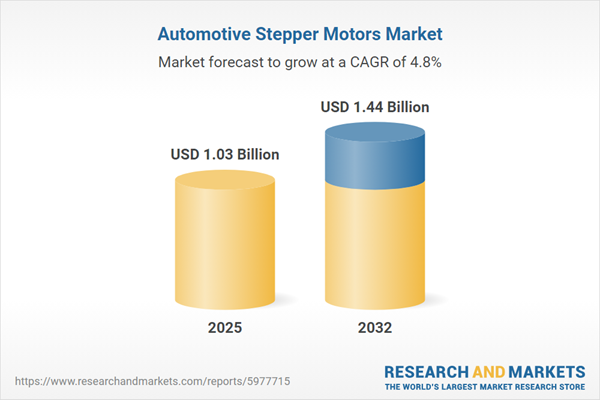Speak directly to the analyst to clarify any post sales queries you may have.
The automotive stepper motors market is evolving rapidly, enabling advanced precision control in modern vehicles. As vehicle architectures and powertrains grow increasingly complex, component reliability, motion accuracy, and seamless system integration have become strategic priorities for OEMs and suppliers alike.
Market Snapshot: Automotive Stepper Motors Market Growth and Opportunity
The Automotive Stepper Motors Market grew from USD 989.95 million in 2024 to USD 1.03 billion in 2025. With a projected CAGR of 4.82%, the market is expected to reach USD 1.44 billion by 2032. As demand continues to rise, stakeholders are rethinking motion actuation strategies to align with changing industry and regulatory requirements.
Scope & Segmentation
- Type: Bipolar stepper motors, Unipolar stepper motors
- Rotor Design: Hybrid stepper motors, Permanent magnet stepper motors, Variable reluctance stepper motors
- Technology: Analog control, Digital control
- Application: EGR actuation, Headlamp actuators, HVAC systems, Throttle control, Turbo actuation
- End-User: Commercial vehicles, Passenger vehicles
- Sales Channel: Aftermarket, OEM
- Regions: Americas (including United States, Canada, Mexico, Brazil, Argentina, Chile, Colombia, Peru), Europe, Middle East & Africa (including United Kingdom, Germany, France, Russia, Italy, Spain, Netherlands, Sweden, Poland, Switzerland, United Arab Emirates, Saudi Arabia, Qatar, Turkey, Israel, South Africa, Nigeria, Egypt, Kenya), Asia-Pacific (including China, India, Japan, Australia, South Korea, Indonesia, Thailand, Malaysia, Singapore, Taiwan)
- Key Companies: AMETEK Inc., Digi-Key Corporation, Emerson Electric Co, Hitachi Automotive Systems, ISL Products International Ltd., Johnson Electric Group, Lin Engineering, MinebeaMitsumi Inc., Mitsubishi Electric Corporation, Nidec Corporation, NMB Technologies Corporation, Oriental Motor Co., Ltd., Robert Bosch GmbH, Sanyo Denki Co., Ltd., Shanghai MOONS' Electric Co., Ltd., Siemens AG, SKS Electronics, Spark Engineering & Automation, STMicroelectronics N.V., TAMAGAWA SEIKI CO., LTD., Texas Instruments Incorporated, Toshiba Corporation, VALEO limited, ZF Friedrichshafen AG
Key Takeaways: Strategic Insights for Automotive Stepper Motor Market Leaders
- Automotive stepper motors are vital in enhancing digital control, operational reliability, and precise motion for both established and next-generation vehicle platforms.
- Electrification, combined with adoption of advanced driver assistance and autonomous systems, is reshaping stepper motor design by demanding higher efficiency, adaptive feedback features, and integration with complex digital architectures.
- Hybrid and permanent magnet designs are enabling new applications by balancing fine control with energy efficiency, while variable reluctance solutions are favored for cost-sensitive projects.
- OEMs and suppliers are working together more closely, aligning innovation roadmaps and co-developing modules to ensure compatibility with evolving vehicle electronics and emissions standards.
- Aftermarket and OEM distribution channels face diverging demands: Aftermarket success depends on fast availability and retrofit compatibility, while OEM supply prioritizes early integration and long-term co-development.
Tariff Impact: Evolving Supply Chains and Cost Structures
Recent United States tariff adjustments have prompted manufacturers to reexamine their sourcing models and invest in regional production. Companies are increasingly seeking nearshoring options to reduce cost exposure, shorten lead times, and reinforce supply chain resilience. In parallel, collaborative ventures and local manufacturing are supporting faster response to fluctuating demand and regulatory shifts, especially in North America.
Methodology & Data Sources
This report leverages a mixed-method approach, integrating secondary research with primary interviews from engineering, procurement, and product leadership roles across the supply chain. Rigorous data triangulation ensures reliability, drawing on patent filings, regulatory documents, and scenario analysis to validate insights and identify actionable trends.
Why This Report Matters
- Enables senior decision-makers to confidently align product and sourcing strategies with the latest market dynamics and regulatory pressures.
- Provides in-depth segmentation and competitive benchmarking for tailored innovation, supply chain, and commercialization initiatives.
- Highlights actionable growth opportunities linked to electrification, advanced digital controls, and global supply realignment.
Conclusion
The automotive stepper motors market is navigating rapid technological and regulatory change, requiring agile responses across R&D, sourcing, and integration strategies. This report arms leaders with in-depth insights and practical recommendations to advance precision actuation and ensure sustained market relevance.
Additional Product Information:
- Purchase of this report includes 1 year online access with quarterly updates.
- This report can be updated on request. Please contact our Customer Experience team using the Ask a Question widget on our website.
Table of Contents
3. Executive Summary
4. Market Overview
7. Cumulative Impact of Artificial Intelligence 2025
Companies Mentioned
The companies profiled in this Automotive Stepper Motors market report include:- AMETEK, Inc.
- Digi-Key Corporation
- Emerson Electric Co
- Hitachi Automotive Systems
- ISL Products International Ltd.
- Johnson Electric Group
- Lin Engineering
- MinebeaMitsumi Inc.
- Mitsubishi Electric Corporation
- Nidec Corporation
- NMB Technologies Corporation
- Oriental Motor Co., Ltd.
- Robert Bosch GmbH
- Sanyo Denki Co., Ltd.
- Shanghai MOONS' Electric Co., Ltd.
- Siemens AG
- SKS ELECTRONICS
- Spark Engineering & Automation
- STMicroelectronics N.V.
- TAMAGAWA SEIKI CO., LTD.
- Texas Instruments Incorporated
- Toshiba Corporation
- VALEO limited
- ZF Friedrichshafen AG
Table Information
| Report Attribute | Details |
|---|---|
| No. of Pages | 185 |
| Published | November 2025 |
| Forecast Period | 2025 - 2032 |
| Estimated Market Value ( USD | $ 1.03 Billion |
| Forecasted Market Value ( USD | $ 1.44 Billion |
| Compound Annual Growth Rate | 4.8% |
| Regions Covered | Global |
| No. of Companies Mentioned | 25 |









